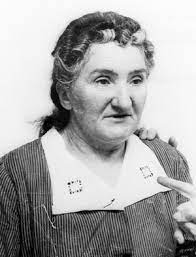Leonarda Cianciulli Made Soaps And Cakes From Her Victims’ Bodies.

Leonarda Cianciulli, also known as “The Soap-Maker of Correggio,” was an Italian serial killer who lured women into her home, killed them, and made soaps and teacakes out of their bodies, which she then sold and served to visitors. She is one of the most infamous female serial killers of the 20th century.
Early life:
Leonarda Cianciulli was born on April 18, 1894, in Montella, Italy. She faced a difficult life which led her to make two failed suicide attempts before reaching adulthood. Despite her mother's objections, Leonarda married Raffaele Pansardi, a registry clerk, in 1917. According to Leonarda, this was when her mother, who had wanted her to marry someone else, placed a curse on her and her husband.
A decade after her marriage, Leonarda was convicted of fraud and served time in prison. Following her release, she relocated her family from Potenza to Lacedonia, near her hometown. In 1930, the Irpinia earthquake caused widespread devastation, and Leonarda's home was among those destroyed.
She subsequently moved her family to Correggio and opened a small shop. Despite her past, Leonarda was well-regarded by those close to her, including friends, family, and neighbors.
Despite her relocation, the misfortune in her life seemed never-ending. She decided to visit a traveling Romani fortune-teller who told her: “In your right hand I see prison… On your left, a criminal asylum.”
The Devoted Mother with a Tragic Past
Prior to her notoriety as "The Soap-Maker of Correggio," Leonarda was a devoted mother who went to great lengths to protect her favorite child and eldest son, Giuseppe Pansardi, during World War II. During her marriage, Leonarda had 17 pregnancies, but only four of her children survived. She suffered three miscarriages and lost ten more children in their youth. Given this, Leonarda was extremely protective and attached to her surviving children.
Given her experiences with three miscarriages and the loss of ten children, it's not surprising that Leonarda exhibited signs of various mental health conditions. She turned to superstition and paranoia as coping mechanisms. Today, clinical psychologists would likely attribute these beliefs to underlying anxiety and depression, as a mind troubled by trauma often seeks ways to make sense of the senseless.
At the time, however, mental health diagnoses and treatments were not as advanced as they are today.
In 1939, Giuseppi chose to join the Italian army to contribute to the war effort. This was after Leonarda's mother had cursed her for marrying a man she didn't approve of, her encounter with a fortune-teller, and her descent into superstition. Driven to ensure her son's safety, Leonarda believed that the only way to protect him was through human sacrifice.

The origin of Leonarda's belief that sacrificing others would protect her son during the war is unknown. The Roman Catholic Church strictly prohibits human sacrifice and condemns those who practice it. There is no evidence of any Romani superstitions that condone such sacrifices. Despite the unclear origins of her beliefs, Leonarda became known as "The Soap-Maker of Correggio" in 1939.
Leonarda's first victim was Faustina Setti, a local spinster whom she lured to her home with the promise of introducing her to a potential suitor. After accepting payment of 30,000 Italian lire for the meeting, Leonarda instructed Faustina to write letters to her relatives claiming she was traveling abroad to meet a man.
She then drugged and murdered Faustina with an ax, dismembered her into nine pieces, collected her blood in a sink, and combined the remains with 7kg of caustic soda to make soap.
After collecting blood, Leonarda allowed it to clot, dried it in an oven, and ground it into a fine powder. She then added the powder to a mixture of flour, sugar, milk, eggs, and chocolate to create crunchy tea cakes. These cakes were served to visitors, and Leonarda later disclosed these actions to the authorities upon her arrest.

Leonarda committed her second murder in 1940. The victim was Francesca Soavi, a woman who had been lured into Leonarda’s house under the guise of a potential teaching opportunity abroad. She used the same methods as she had for Faustina to kill Francesca: drugging her wine, killing her with an ax, baking her into teacakes, and stealing her money.
Leonarda's third target was the renowned soprano, Virginia Cacioppo. She enticed her with the opportunity of a job with a prominent impresario in Florence. Upon arrival at Leonarda's home, Virginia was murdered in the same manner as the previous two victims. This time, however, Leonarda melted the victim's flesh to create soap.
Final Years
The disappearance of Leonarda's third and final victim, Virginia Cacioppo, raised concerns among her family, particularly her sister-in-law who was suspicious of the letters claiming her hasty departure. This led the sister-in-law to report the case to the Reggio Emilia police, informing them that she had seen her sister entering Leonarda's home on the night of her alleged departure. This prompted the police to immediately initiate an investigation into Leonarda.
At first, Leonarda fiercely defended herself. However, when the police started suspecting her beloved son, whom she had been trying to protect all along, she collapsed and admitted to all of her crimes. She was eventually found guilty and sentenced to 33 years in prison and 3 years in a criminal asylum, which was eerily in line with the prediction she received from a Romani fortune-teller.
Leonarda passed away from a cerebral stroke at the age of 79, while she was still in the criminal asylum. Her remains were returned to her family for a proper burial. However, the tools and weapons she used to murder and cook her victims were kept in the Criminology Museum in Rome, where they can still be viewed today.

 My First News Item
My First News Item My Nine News Item
My Nine News Item